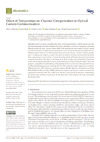Identificador persistente para citar o vincular este elemento:
https://accedacris.ulpgc.es/handle/10553/77395
| DC Field | Value | Language |
|---|---|---|
| dc.contributor.author | Moreno, Daniel | en_US |
| dc.contributor.author | Rufo, Julio | en_US |
| dc.contributor.author | Guerra, Víctor | en_US |
| dc.contributor.author | Rabadán, José | en_US |
| dc.contributor.author | Pérez-Jiménez, Rafael | en_US |
| dc.date.accessioned | 2021-02-01T08:25:16Z | - |
| dc.date.available | 2021-02-01T08:25:16Z | - |
| dc.date.issued | 2021 | en_US |
| dc.identifier.issn | 2079-9292 | en_US |
| dc.identifier.other | Scopus | - |
| dc.identifier.uri | https://accedacris.ulpgc.es/handle/10553/77398 | - |
| dc.description.abstract | General-purpose Complementary Metal Oxide Semiconductor (CMOS) sensors perform the image desegregation in three channels (red, green, and blue) as a result of a band-pass wavelength filtering carried out using Foveon or Bayer filters. This characteristic can be used in Optical Camera Communication (OCC) systems for increasing the links’ data rate by introducing Wavelength Division Multiplexing (WDM) or Color Shift Keying (CSK) modulation schemes. However, these techniques need a compensation stage to mitigate the cross-talk between channels introduced by the filters. This compensation is performed by a Channel State Information (CSI) estimation and a zero-forcing compensation scheme. The impact of the temperature effects of light-emitting diode (LED) emissions on the zero-forcing compensation scheme’s performance has not been analyzed in depth. This work presents a comprehensive methodology and experimental characterization of this impact for Foveon and Bayer-based image sensors, assuming that the CSI is estimated under temperature conditions different from the LED’s stationary temperature regime. Besides, Signal-to-Interference-plus-Noise Ratio (SINR) and Bit Error Rate (BER) performance metrics are presented in order to estimate the repercussion in an OCC link. The results reveal that the Foveon sensor obtains more unsatisfactory performance than the Bayer-based sensor. On the other hand, the blue band is the most penalized by the thermal effect. | en_US |
| dc.language | eng | en_US |
| dc.relation.ispartof | Electronics (Switzerland) | en_US |
| dc.source | Electronics (Switzerland)[EISSN 2079-9292],v. 10 (3), p. 1-20, (Enero 2021) | en_US |
| dc.subject | 3307 Tecnología electrónica | en_US |
| dc.subject.other | Channel Compensation | en_US |
| dc.subject.other | Led | en_US |
| dc.subject.other | Optical Camera Communication | en_US |
| dc.subject.other | Spectrum | en_US |
| dc.subject.other | Channel compensation | en_US |
| dc.title | Effect of temperature on channel compensation in optical camera communication | en_US |
| dc.type | info:eu-repo/semantics/Article | en_US |
| dc.type | Article | en_US |
| dc.identifier.doi | 10.3390/electronics10030262 | en_US |
| dc.identifier.scopus | 85099683157 | - |
| dc.contributor.authorscopusid | 57207874243 | - |
| dc.contributor.authorscopusid | 35168120700 | - |
| dc.contributor.authorscopusid | 55650664600 | - |
| dc.contributor.authorscopusid | 6701924182 | - |
| dc.contributor.authorscopusid | 56044417600 | - |
| dc.identifier.eissn | 2079-9292 | - |
| dc.description.lastpage | 20 | en_US |
| dc.identifier.issue | 3 | - |
| dc.description.firstpage | 1 | en_US |
| dc.relation.volume | 10 | en_US |
| dc.investigacion | Ingeniería y Arquitectura | en_US |
| dc.type2 | Artículo | en_US |
| dc.utils.revision | Sí | en_US |
| dc.date.coverdate | Enero 2021 | en_US |
| dc.identifier.ulpgc | Sí | en_US |
| dc.contributor.buulpgc | BU-TEL | en_US |
| dc.description.sjr | 0,59 | |
| dc.description.jcr | 2,69 | |
| dc.description.sjrq | Q2 | |
| dc.description.jcrq | Q3 | |
| dc.description.scie | SCIE | |
| dc.description.miaricds | 10,5 | |
| item.grantfulltext | open | - |
| item.fulltext | Con texto completo | - |
| crisitem.author.dept | GIR IDeTIC: División de Fotónica y Comunicaciones | - |
| crisitem.author.dept | IU para el Desarrollo Tecnológico y la Innovación | - |
| crisitem.author.dept | GIR IDeTIC: División de Fotónica y Comunicaciones | - |
| crisitem.author.dept | IU para el Desarrollo Tecnológico y la Innovación | - |
| crisitem.author.dept | GIR IDeTIC: División de Fotónica y Comunicaciones | - |
| crisitem.author.dept | IU para el Desarrollo Tecnológico y la Innovación | - |
| crisitem.author.dept | GIR IDeTIC: División de Fotónica y Comunicaciones | - |
| crisitem.author.dept | IU para el Desarrollo Tecnológico y la Innovación | - |
| crisitem.author.dept | Departamento de Señales y Comunicaciones | - |
| crisitem.author.dept | GIR IDeTIC: División de Fotónica y Comunicaciones | - |
| crisitem.author.dept | IU para el Desarrollo Tecnológico y la Innovación | - |
| crisitem.author.dept | Departamento de Señales y Comunicaciones | - |
| crisitem.author.orcid | 0000-0003-1336-7365 | - |
| crisitem.author.orcid | 0000-0002-2269-6729 | - |
| crisitem.author.orcid | 0000-0002-6264-7577 | - |
| crisitem.author.orcid | 0000-0002-9994-4495 | - |
| crisitem.author.orcid | 0000-0002-8849-592X | - |
| crisitem.author.parentorg | IU para el Desarrollo Tecnológico y la Innovación | - |
| crisitem.author.parentorg | IU para el Desarrollo Tecnológico y la Innovación | - |
| crisitem.author.parentorg | IU para el Desarrollo Tecnológico y la Innovación | - |
| crisitem.author.parentorg | IU para el Desarrollo Tecnológico y la Innovación | - |
| crisitem.author.parentorg | IU para el Desarrollo Tecnológico y la Innovación | - |
| crisitem.author.fullName | Moreno Gázquez,Juan Daniel | - |
| crisitem.author.fullName | Rufo Torres,Julio Francisco | - |
| crisitem.author.fullName | Guerra Yanez, Victor | - |
| crisitem.author.fullName | Rabadán Borges, José Alberto | - |
| crisitem.author.fullName | Pérez Jiménez, Rafael | - |
| Appears in Collections: | Artículos | |
SCOPUSTM
Citations
10
checked on Jun 8, 2025
WEB OF SCIENCETM
Citations
9
checked on Jun 8, 2025
Page view(s)
108
checked on Sep 2, 2023
Download(s)
98
checked on Sep 2, 2023
Google ScholarTM
Check
Altmetric
Share
Export metadata
Items in accedaCRIS are protected by copyright, with all rights reserved, unless otherwise indicated.
